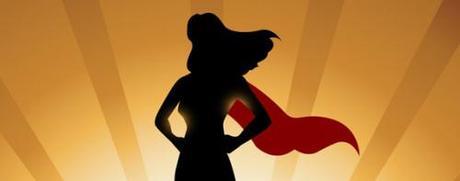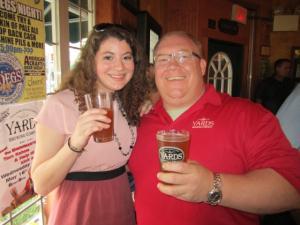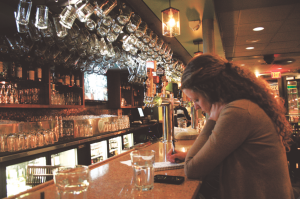
When I first began thinking months ago about my recent series of posts on gender and beer, I centered them around this question:
Can women save beer?
That theme was inherently flawed, not only because the onus shouldn’t be on only women, but also because it wasn’t entirely clear if “beer” as an industry needed saving in the first place. However, I feel it’s impossible to overlook at least some of the shortcomings when it relates to beer and gender, so while “saving” may be a strong way to put it, a shift in cultural expectations within beer would still be advantageous.
While I’ve given my two cents on the topic, it would make no sense to approach this without the input of beer-minded women. So as part of my effort, I reached out to a few women via email to gauge their thoughts on the topic.
Perhaps unsurprising, two women shared a similar experience of cultural expectations – when out with their husbands, it came as a surprise they were the beer drinkers.

Molly Kinne of Tap Dancer Blog.
“I have had the experience more than once of having the cider my husband ordered placed in front of me because obviously it was the woman who ordered the cider and the man who ordered the IPA,” said Molly Kinne of Tap Dancer Blog. “I recently started working at a beer store that focuses on local and craft beer. For the most part customers seem to value my input, but there have been a few instances where I have pointed out a few options with no response then I say ‘my husband likes this one’ and that’s the one that goes home with them.”
A similar problem happens with Ashley Bower, a South Carolina beer advocate and organizer of South Carolina Girls’ Pint Out, a chapter of the female-focused nationwide organization that works to increase knowledge of beer through collaboration with women. Ashley’s husband doesn’t drink beer, but said she’s often put in the position where servers will address him when ordering beer, not her.

Ashley Bower at a SC Girls’ Pint Out meeting.
“There has been more than one occasion where I’ve been out with a group and a male I don’t know just assumed I didn’t know anything about beer,” she said. “Or, I’ll walk in a brewery that doesn’t know me and they’ll suggest I try the blonde ale without asking what I normally drink. There’s nothing wrong with trying the blonde, but I like all sorts of other beer styles.”
Therein lies a common problem. In my first post on gender and beer, I thought this comment was particularly telling:
“Why is all of your marketing geared towards men? Are you convinced that women prefer wine and will not switch to beer?” [Large beer company marketing manager] told me, “We understand the female market is a huge opportunity for us. We have lots of new products that are in the works to specifically market to women.” I took this as code for apricot or blueberry flavored beer.
This stems from our own expectations of how women are supposed to interact with beer, something for which Tierney Pomone takes issue. Tierney, founder of Stouts and Stilettos, doesn’t care for the stereotype that there is a particular kind of beer for a particular gender.
While Tierney admits the craft beer culture is much more welcoming than how Big Beer typically addresses women, there are still moments that make her shake her head.

Tierney Pomone of Stouts and Stilettos.
“For example, when you say you’re into beer and they don’t believe you, but for men it’s never questioned,” she said. “Or when you say you don’t know what you want yet, mostly because you need more time to read the menu, and [servers] immediately recommend what they consider to be a ‘girl beer.’ “
So how can we better integrate women into an industry we’ve otherwise cordoned off for men? I got a great response from Heather Vandenengel, a freelance beer writer and blogger at Beer Hobo.

Heather Vandenengel doing research.
Last summer, Heather volunteered at Girls Rock Camp, whose mission she described as “to build self-esteem of girls by teaching them music and just letting them rock out, no judgment, no fear, just total positive encouragement.” Throughout the camp, girls up to 16 years old learn to play instruments, then perform an original song at the end of camp.
What struck Heather (and me when she shared this) was how unique that experience truly is for females.
“It was a totally amazing experience and also mind-blowing in that you realize how hard positive, self-esteem building support is to come by for girls, and even all women,” Heather said. “And how women and girls don’t hear nearly enough that it’s okay not to be perfect.”
How does this all relate to gender and beer? I’ll let Heather take it from here:
It relates to beer because I was thinking about playing an instrument in relation to homebrewing. How many guys just decide they want to make beer, pick up a kit and try it out and aren’t deterred when the beer ends up turning out like crap/decide they want to learn guitar or drums and bang away at it until they’re decent? And how many guys have gotten a homebrewing kit/guitar for Christmas or a birthday because that falls in line with the cultural norm?
There is a tremendous amount of pressure on women to be perfect in all that they do, whether it’s playing a guitar or homebrewing, so my thesis is that we need to get more women homebrewing because that’s where the majority of brewers get their start, and where a significant shift within beer culture could occur.
This again returns to the idea of beer as a purely masculine product, entrenched in our cultural expectations for how we can approach it. From early ages, we make it difficult for females to even consider approaching a “male” subject. It’s an unfortunate norm hammered home by a variety of industries and social groups, beer among them.
As I mentioned in my last post, this is a topic with great depth and there is no silver bullet to fix wrongs of the industry. Issues of gender are not unique to any one culture or industry.
However, expectations start with us and our own biases. Finding a solution isn’t easy, but looking inward is a start.

